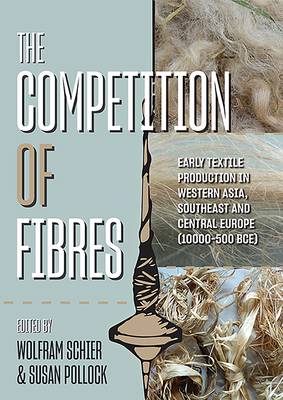
- Retrait gratuit dans votre magasin Club
- 7.000.000 titres dans notre catalogue
- Payer en toute sécurité
- Toujours un magasin près de chez vous
- Retrait gratuit dans votre magasin Club
- 7.000.0000 titres dans notre catalogue
- Payer en toute sécurité
- Toujours un magasin près de chez vous
The Competition of Fibres
Early Textile Production in Western Asia, Southeast and Central Europe (10,000-500 Bc)
63,95 €
+ 127 points
Description
The central issues discussed in this new collected work in the highly successful ancient textiles series are the relationships between fiber resources and availability on the one hand and the ways those resources were exploited to produce textiles on the other. Technological and economic practices - for example, the strategies by which raw materials were acquired and prepared - in the production of textiles play a major role in the papers collected here.
Contributions investigate the beginnings of wool use in western Asia and southeastern Europe. The importance of wool in considerations of early textiles is due to at least two factors. First, both wild as well as some domesticated sheep are characterized by a hairy rather than a woolly coat. This raises the question of when and where woolly sheep emerged, a question that has not up to now been resolvable by genetic or other biological analyses. Second, wool as a fiber has played a major role both economically and socially in both western Asian and European societies from as early as the 3rd millennium BCE in Mesopotamia, and it continues to do so, in different ways, up to the modern day. Despite the importance of wool as a fiber resource contributors demonstrate clearly that its development and use can only be properly addressed in the context of a consideration of other fibers, both plant and animal. Only within a framework that takes into account historically and regionally variable strategies of procurement, processing, and the products of different types of fibers is it possible to gain real insights into the changing roles played by fibers and textiles in the lives of people in different places and times in the past.
With relatively rare, albeit sometimes spectacular exceptions, archaeological contexts offer only poor conditions of preservation for textiles. As a result, archaeologists are dependent on indirect or proxy indicators such as textile tools (e.g., loom weights, spindle whorls) and the analysis of faunal remains to explore a range of such proxies and methods by which they may be analyzed and evaluated in order to contribute to an understanding of fiber and textile production and use in the past.
Contributions investigate the beginnings of wool use in western Asia and southeastern Europe. The importance of wool in considerations of early textiles is due to at least two factors. First, both wild as well as some domesticated sheep are characterized by a hairy rather than a woolly coat. This raises the question of when and where woolly sheep emerged, a question that has not up to now been resolvable by genetic or other biological analyses. Second, wool as a fiber has played a major role both economically and socially in both western Asian and European societies from as early as the 3rd millennium BCE in Mesopotamia, and it continues to do so, in different ways, up to the modern day. Despite the importance of wool as a fiber resource contributors demonstrate clearly that its development and use can only be properly addressed in the context of a consideration of other fibers, both plant and animal. Only within a framework that takes into account historically and regionally variable strategies of procurement, processing, and the products of different types of fibers is it possible to gain real insights into the changing roles played by fibers and textiles in the lives of people in different places and times in the past.
With relatively rare, albeit sometimes spectacular exceptions, archaeological contexts offer only poor conditions of preservation for textiles. As a result, archaeologists are dependent on indirect or proxy indicators such as textile tools (e.g., loom weights, spindle whorls) and the analysis of faunal remains to explore a range of such proxies and methods by which they may be analyzed and evaluated in order to contribute to an understanding of fiber and textile production and use in the past.
Spécifications
Parties prenantes
- Editeur:
Contenu
- Nombre de pages :
- 240
- Langue:
- Anglais
- Collection :
- Tome:
- n° 36
Caractéristiques
- EAN:
- 9781789254297
- Date de parution :
- 13-05-20
- Format:
- Livre broché
- Format numérique:
- Trade paperback (VS)
- Dimensions :
- 216 mm x 277 mm
- Poids :
- 839 g

Les avis
Nous publions uniquement les avis qui respectent les conditions requises. Consultez nos conditions pour les avis.





